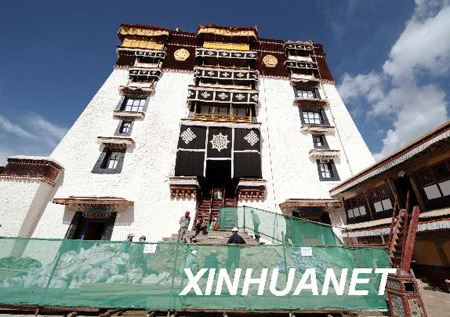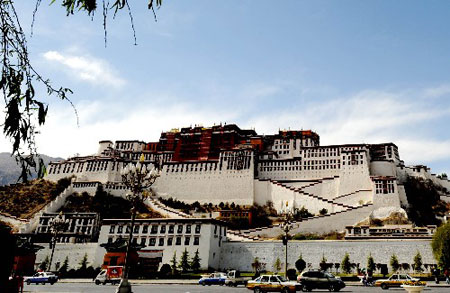The second-phase restoration of the world-famous Potala Palace has been proceeding smoothly and is set to be completed by the end of this year.
The renovation of the stone-wood structure, which was started in June, 2002, combines the traditional maintenance skills with the modern technology, according to the Office of Renovation of the Three Cultural Relics of Tibet Autonomous Region.

Photo taken on April 14, 2008 shows technicians repair a sleeper wall newly discovered in the Potala Palace in in Lhasa, capital of southwest China's Tibet Autonomous Region, photo from Xinhua.
The second-phase project involves 55 sub-projects, with the focus on maintaining the ancient building, the murals, its environment, improving and upgrading public facilities like fire prevention, drainage system, and lightning protection.
China's Central Government earmarked 200 million yuan (29.3 million U.S. dollasrs) for the renovation, said Nyima Tsering, an official of the Office of Renovation of the Three Cultural Relics of Tibet Autonomous Region.
By now, the renovation of 51 sub-projects has been started, with the total financing amounting to 170 million yuan (24.9 million dollars), he added.

Photo taken on May 2, 2009, shows the exterior of the Potala Palace, Lhasa, capital of southwest China's Tibet Autonomous Region, photo from Xinhua.
The key part of the renovation involves the sleeper walls, walls used to support floor joists of a ground floor. During the renovation, 491 such walls have been discovered, with 487 having been repaired to date.
According to the restoration plan, 1,722.68 sq m of the murals will be repaired. So far, murals at 16 sites of the palace have been finished, with the restored area hitting 1,743.73 sq m.
From 1989 to 1994, the Central Government allotted more than 50 million yuan (7.32 million dollars) for the first-phase renovation of the Potala Palace, which helped it regain its past splendor and magnificence.

A heavy rainfall in 1998 caused the collapse of some parts of the palace, making it imperative to begin another phase of restoration.
Photo taken on Jan. 7, 2009 shows a worker works inside a treasure house at the Potala Palace in Lhasa, capital of southwest China's Tibet Autonomous Region, photo from Xinhua.
The Potala Palace was first built in 641 by Songtsan Gambo, ruler of the Tubo Kingdom, for Princess Wencheng of the Tang Dynasty. The complex was later burned down to the ground during a war and was rebuilt in the 17th century by the Fifth Dalai Lama. Repeated repairs and expansions until 1645 finally brought the palace to its present scale.
In 1994, the palace was designated as one of the world cultural heritage sites by the United Nations Educational, Scientific, and Cultural Organization (UNESCO).
